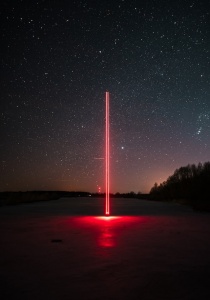
Photo by Vadim Sadovski on Unsplash
“Alright people what have we got.”
The room was secret, secure, and unknown except for the people invited in, though the topic focused on what the entire planet was talking about: the light spear carving its way across the planet at incredible speeds.
Dr. Cuvier jumped in. “Estimated death toll, about 100,000 thanks to the cut through Imphal slums. Hawaii is bracing for its turn in two hours.”
“Earthquakes are subsiding. The cut is only about six millimeters wide,” Dr. Agassiz responded when eyes rotated to him from the population expert.
“We’re in America. Give me inches boy.”
The scientists around the table winced, a few breaking out their phones to do quick calculations.
“A quarter inch, a little less.” Dr. Agassiz answered promptly without the phone consult. “Atmosphere turbulence has some rain effects, making mudslides likely in Asia, and preliminary computer modeling indicate mudslides over the next few days.”
“The beam is hovering about,” the woman next around the table glanced at her phone, “a foot above sea level. ”
Someone across the table, not any of the three men in military uniform or the man in a freshly pressed suit sitting in between them, interrupted. “Wait, it’s not going below sea level? I thought it was cutting through mountains.”
The woman glanced at those in charge and the civilian nodded his head, so she responded. “Most mountains we care about are above sea level. As geology indicated, the damage from beam is about a quarter inch across, but the full light effect is closer to four feet diameter. We got eyes on it in Mexico and I have a video if anyone wants to see it. It moves too fast to verify its shape, though we suspect a perfectly round cone, but we are working with our Hawaii group for better visuals. Modeling is backtracking it and we are swinging around telescopes.”
“Thank you, Dr. Horner. Acquisition any resources you need for that modeling.” the vice president said before moving his eyes to the next in line.
“Only two satellites are down so far, working on moving the two GPS over Hawaii out of the path now.” the telecommunication specialist immediately dropped her eyes to the largest phone in the room. Those next to her noticed her screen provided real-time data; somehow it worked through the shielding and scrambling.
Dr. Horner squished down the jealousy of the specialist getting permission to bring that device in the room. She queued her note for resource acquisition to send out to her team the minute she made it back to the surface.
“Whatever the source, it’s stationary in relation to the planets,” said a man leaning back in his chair, arms crossed.
One of the military officers raised a hand, before rolling it around in a circle. “Wait, backup, how can that be? It’s going across the planet at nearly 1,000 miles per hour.”
“Actually,” Dr. Lehmann sighed the longsuffering sigh of someone used to explaining things to those less informed, “the planet is rotating about 1,000 miles per hour under the beam. The source of the light spear doesn’t have to move except to follow the planet around our star. It’s a lazy man’s solution. Lazy alien solution, I guess.”
The military man narrowed his eyes at the astrophysicist, not liking the lack of respect at all, but managed to say with flat professionalism, “Thank you.”
The doctor shrugged.
The important eyes switched sides of the table to the man who had interrupted. “Eugene, speculation?”
“Bear with me a moment. First, I want to get rid of what everyone’s first reaction is. It isn’t an alien weapon.”
“Yeah, right.” Someone muttered snidely from the brainstorming side.
“Can’t be. Too automated. This is a probe, a six-millimeter probe.”
Dr. Horner raised a finger and Eugene Bascom nodded at her. “Its damage is six-millimeters, the beam is 1.314 meters wide.”
“Good point. Thanks.” Eugene, best selling science fiction writer and Georgetown University professor of biochem leaned back to think a moment. “The beam vaporized everything.”
The white-hair hunched-back female next to him shuffled her papers. “Nothing has stopped it yet. In Mexico, they tried several reflective surfaces without effect. Diamond, platinum, even q-carbon.”
“The damage area is a probe, the rest of it is … analyzing? Yes, what is a probe without analyzing the results.”
The telecommunication specialist, who didn’t even bother with a name tag like the rest of them, spoke up, “Spectral analysis of the vaporized material.”
Eugene blinked, gulped, looked at the vice president before suggesting quietly, “It’s a mining probe.”
“Mining what?” the man in charge asked, knowing his grandson’s favorite teacher was about to give an answer he really didn’t want to hear.
The scientist eyes unfocused until the fiction writer half of his brain came back with the answer, “Atmosphere.”
“Fuck,” slipped past Dr. Horner’s lips. “Yes, that is why it focused in the area above sea level. It only cares about atmosphere. The hits on the mountains are incidental.”
“Exactly, what is five miles compared to six thousand?”
“Hey, just got a message in.” the telecommunication specialist rocked her phone, “confirmed probe activity on Mars, Jupiter, and Saturn. Nothing on Mercury or Venus.”
The astrophysicist snorted. “Lazy aliens indeed. Mercury and Venus have the slowest rotation rates. Venus is over 200 days.”
“And Mercury doesn’t have an atmosphere to speak of.” Dr. Bascom nodded to himself. “Solar system wide mining operation or just looking for the right planet to exploit?”
Dr. Horner winced. “Anything needing a planet’s atmosphere is likely just figuring out the right tools for the job. They are going to—”
“strip everything.” Eugene overtalked Dr. Horner and finished her sentence. “Exactly, our world, the entire system.”
“But, but,” the population expert injected, “this is a habitable planet. There are PEOPLE here.”
The professor shook his head at Dr. Cuiver’s naiveite. “Since when have exploiters cared about the indigenous people?”
“If they mine systems, they are a space-going race, likely entirely space-going.” Dr. Horner said, “And they don’t—”
“care about the planet bound at all.” Dr. Bascom interrupted.
The telecommunication specialist slapped her hand down on the table. “Stop that.”
Everyone blinked.
“Look I get it,” the woman set aside her hand-held, her dark black eyes boring in the blue eyes of the professor, “you are the smartest boy in the room in a group of very smart boys. Four to one ratio male to female. But you.will.not.interrupt.this.woman.again.” The non-doctor narrowed her eyes. “Not if you EVER want to have your computers virus free. At least, don’t interrupt Dr. Horner again today.” The tech stared at the professor until he nodded understanding, somehow both glaring in anger and looking contrite in apology at being caught out. The tech, leaned back smiling, and picked back up her phone. “Carry-on.”
The two military officers side by side on the left side of the vice president smiled at each other. “Oh, I want her as a drill sergeant.”
“Don’t patronize.” The specialist muttered, her fingers moving over the screen with her eyebrows scrunching together in concentration, before speaking clearer, louder, addressing the table in general. “Confirmed activity on Uranus, though some of you are going to have to explain to me at some point how a planet rotates vertically from the normal rotational plane. Oh, and the Jupiter probes are confirmed for the 25 parallel north, south, and is starting the 50th parallel north.”
The right-side military officer growled, “So there will be more.”
The vice president looked around the table. “Better move this upstairs where we got better communication. Dr. Horner, I want that backtrack ASAP, on all the probes. Are we dealing with one or several? Ms. Chow help her get all the computer power she needs pronto. I’ll talk to the president, y’all talk to your people, and your aides will tell you where we reconvene after lunch.”
One guy with wings on his shirt who hadn’t reported yet spoke up as people started to stand. “One thing, when you talk to the president. If this continues, the turbulence will get bad. We will need to shut down air travel. India already has done so.”
The civilian in charge grimaced. “I’ll mention that to her.”
(words 1,374, first published 9/15/2022)
Series: Light Spear
- Light Spear – link to 11/28/2021
- Light Spear Expanded – link to 12/5/2021






 Quantum mechanics doesn’t live in our normal space-and-time continuum, well, it does, but it breaks a lot of “rules” normal physics have. Kind-of like the rules of adults don’t apply to babies, the rules of molecules doesn’t apply to the parts that make up atoms. Smaller things always gets different rules. They are the baby – got to love them.
Quantum mechanics doesn’t live in our normal space-and-time continuum, well, it does, but it breaks a lot of “rules” normal physics have. Kind-of like the rules of adults don’t apply to babies, the rules of molecules doesn’t apply to the parts that make up atoms. Smaller things always gets different rules. They are the baby – got to love them.